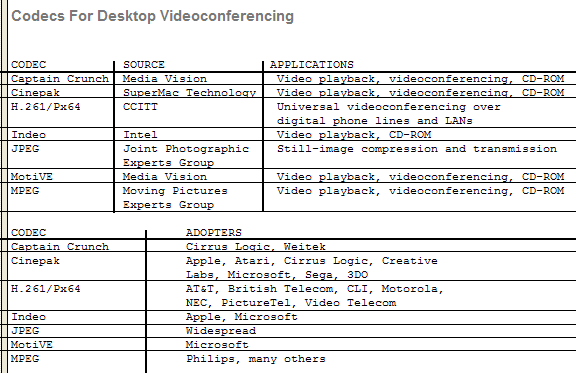| Imagine if you couldn't send a fax outside your company
because the recipient's fax machine recognized a different
transmission standard than yours. Or suppose the public
telephone system lacked sufficient bandwidth to handle a
fax transmission at all. Welcome to videoconferencing,
1993. But there is hope. The CCITT, which established the Group 3 standard that lets fax machines communicate worldwide, is trying to bring the same order to videoconferencing. It is promoting a specification known as H.261 (pronounced "H-dot-261") or Px64 ("P times 64"). H.261 defines a scheme for sending video at speeds of from 64 Kbps to 2 Mbps. At the low end of the spectrum, H.261 fits into an ISDN channel; at the high end, it needs wider-bandwidth dedicated lines, such as T1. The standard defines a video window of 352 by 288 pixels, known as CIF (Common Intermediate Format). It also supports QCIF (Quarter CIF), a smaller window of 176 by 144 pixels. Related specifications cover still-frame graphics, call-setup protocols, and other issues. Large conference-room video systems, such as those from PictureTel (Peabody, MA) and Compression Labs (San Jose, CA) , traditionally rely on their own proprietary codecs, although they offer H.261 as an option. In the desktop market, not everyone seems to be greeting H.261 with open arms. "The problem with H.261 is that it lends itself to very, very expensive hardware," says Paul Nahi, a product director at Media Vision (Fremont, CA). "Videoconferencing will become popular when, and only when, you can set up a node for under $200. That's $200 for the plug-in board, the software, and the camera." Media Vision is pushing its own proprietary codecs known as MotiVE (Motion Video Engine) and Captain Crunch. MotiVE is a codec that's licensed to Microsoft for use with Video for Windows. Captain Crunch is a newer codec that will be available on a pair of chips for under $40 by the end of the year. Media Vision intends to sell the chip set to other vendors and use it in a line of desktop video products. Weitek (Sunnyvale, CA) is developing a new family of chips that will improve playback in Video for Windows and eventually support the most popular codecs, including Captain Crunch, Cinepak, MPEG, and Intel's Indeo. Intel (Santa Clara, CA) and Microsoft (Redmond, WA) are backing Indeo for desktop video, although Microsoft has also licensed Cinepak for use with Video for Windows. Intel's Smart Video Recorder, an ISA board for PCs, uses the Intel 750 video processor and Indeo to capture and record live video onto a hard disk in real time. Although Intel has alliances with Bell Atlantic and Ameritech and is known to be working on desktop videoconferencing products, it's not clear if it will implement Indeo, H.261, or some other codec. "Our policy is to follow existing standards when they make sense, and to introduce new standards if they don't already exist or [existing ones] don't offer a good solution," says Scott Darling, marketing director of Intel's business communications division. AT&T Microelectronics' (Berkeley Heights, NJ) AVP-1000 chip set supports H.261/Px64 and MPEG for full-motion video, plus JPEG for still-image compression. Motorola (Austin, TX) and BT (London, U.K.) are also developing a chip set that supports H.261, MPEG, and JPEG. Those chips will appear on PC expansion boards from BT next year. Nearly everyone is focusing on ISDN or LANs as the minimum requirement for acceptable video quality. But start-up company Knex (Fremont, CA) says it will soon introduce the Holy Grail of video codecs: a radical new compression scheme that can send 320- by 240-pixel color images at 15 frames per second over POTS (plain old telephone system) with a transmission delay of under 200 milliseconds. "Our goal is to make it possible for any two people on the face of the earth to communicate with each other visually over ordinary phone lines," says Steve Johnson, Knex's chief operating officer. That goal has eluded everyone since the first prototype videophones drew curious crowds at the 1964 World's Fair in New York. But until the codec chaos is resolved, videoconferencing will be more local than global. Codecs For Desktop Videoconferencing

Tom R. Halfhill is a BYTE senior news editor. You can reach him on BIX as "thalfhill." Copyright 1994-1997 BYTE |